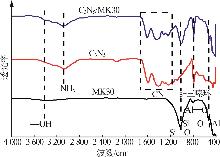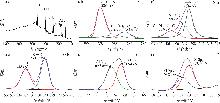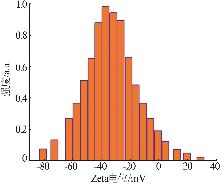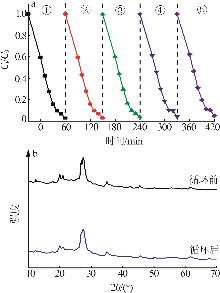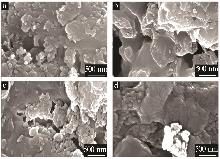Inorganic Chemicals Industry ›› 2025, Vol. 57 ›› Issue (10): 129-138.doi: 10.19964/j.issn.1006-4990.2024-0675
• Catalytic Materials • Previous Articles Next Articles
Study on degradation of organic pollutants by C3N5/Montmorillonite cement coating on concrete surface
XU Shanshan1( ), WANG Wenda2(
), WANG Wenda2( ), LI Shengyong2, XU Hongmei2
), LI Shengyong2, XU Hongmei2
- 1. Inner Mongolia Vocational and Technical College of Communications,Chifeng 024005,China
2. Hetao College,Bayannaoer 015000,China
-
Received:2024-12-13Online:2025-10-10Published:2025-08-12 -
Contact:WANG Wenda E-mail:xvss198506@163.com;wwd198102@126.com
CLC Number:
Cite this article
XU Shanshan, WANG Wenda, LI Shengyong, XU Hongmei. Study on degradation of organic pollutants by C3N5/Montmorillonite cement coating on concrete surface[J]. Inorganic Chemicals Industry, 2025, 57(10): 129-138.
share this article
Table 2
Performance comparison of different carbon nitride-based photocatalytic materials"
| 催化剂 | 底物质量浓 度/(mg·L-1) | 光源 | 光照时 间/min | 表观速率 常数/min-1 | 降解率/% |
|---|---|---|---|---|---|
| GeO2/g-C3N4[ | 50 | 300 W 氙灯 | 90 | 0.033 3 | 96.4 |
| g-C3N4/TiO2[ | 20 | 300 W 氙灯 | 30 | — | 85.4 |
| g-C3N5/g-C3N4[ | 20 | 500 W 氙灯 | 60 | 0.090 5 | 99.8 |
| Ag/g-C3N4[ | 20 | 可见光 | 40 | 0.029 5 | 69.6 |
| C3N5/MK30 | 200 | 500 W 氙灯 | 60 | 0.049 4 | 97.15 |
| [1] | YAGHMOUR E, QAMAR M ABU, NAITO C,et al.Pressure drop and heat transfer properties for normal weight and lightweight pervious concrete[J].Construction and Building Materials,2024,425:135947. |
| [2] | KHAN M A, AHMAD J, KHAN H A,et al.High strength rubberized porous concrete for sustainable pavements:Engineering properties and life cycle assessment[J].Journal of Cleaner Production,2024,451:142012. |
| [3] | 赵文璞,赵晓东,季惠明,等.SiO2/g-C3N4复合材料的3D打印制备及对染料废水的处理性能[J].工业水处理,2024,44(3):64-73. |
| ZHAO Wenpu, ZHAO Xiaodong, JI Huiming,et al.Preparation of SiO2/g-C3N4 composite material by 3D printing and its treatment properties for wastewater containing dyes[J].Industrial Water Treatment,2024,44(3):64-73. | |
| [4] | 左广玲,王明辉,彭云颖,等.蜂巢状LaVO4/Bi2O3异质结光催化降解盐酸四环素的研究[J].无机盐工业,2024,56(11):158- 164. |
| ZUO Guangling, WANG Minghui, PENG Yunying,et al.Study on hnoneycomb-like LaVO4/Bi2O3 heterojunction for photocatalytic degradation of tetracycline hydrochloride[J].Inorganic Chemicals Industry,2024,56(11):158-164. | |
| [5] | 韩龙,刘思乐,张申奥,等.SnS2/C3N5光催化剂的制备及其对亚甲基蓝的光催化降解[J].印染,2025,51(1):10-14. |
| HAN Long, LIU Sile, ZHANG Shen′ao,et al.Preparation of SnS2/C3N5 photocatalyst and its photocatalytic degradation of Methylene Blue[J].China Dyeing & Finishing,2025,51(1):10-14. | |
| [6] | ZHANG Junlei, TAO Hengcong, WU Shanshan,et al.Enhanced durability of nitric oxide removal on TiO2(P25) under visible light:Enabled by the direct Z-scheme mechanism and enhanced structure defects through coupling with C3N5 [J].Applied Catalysis B:Environmental,2021,296:120372. |
| [7] | LONG Jieqing, WEI Liang, HUANG Haizan,et al.Facile fabrication of biochar-coupled g-C3N5/C and its enhanced photocatalytic properties[J].Journal of Physics and Chemistry of Solids,2022,171:111029. |
| [8] | MA Zhanqiang, GUO Wei, ZHANG Kaiyue,et al.Liquid exfoliation of bulk g-C3N5 to nanosheets for improved photocatalytic antibacterial activity[J].Environmental Science and Pollution Research,2023,30(26):69486-69498. |
| [9] | YIN Hongfei, YUAN Chunyu, LV Huijun,et al.The interface design of(0D/2D/1D) AgI/BiOI/C3N5 dual Z-scheme heterostructures with efficient visible-light-driven photocatalytic activity[J].Separation and Purification Technology,2023,308:122815. |
| [10] | LIU Tianyu, YANG Guojiang, WANG Wei,et al.Preparation of C3N5 nanosheets with enhanced performance in photocatalytic methylene blue(MB) degradation and H2-evolution from water splitting[J].Environmental Research,2020,188:109741. |
| [11] | LIAO Wenning, YANG Zhiquan, WANG Ying,et al.Novel Z-scheme Nb2O5/C3N5 photocatalyst for boosted degradation of tetracycline antibiotics by visible light-assisted activation of persulfate system[J].Chemical Engineering Journal,2023,478:147346. |
| [12] | ZHANG Hongda, ZHAO Yunzhe, XU Guanghui,et al.Photocatalytic activation of sodium percarbonate by C3N5/C2N3 homojunction for rapid water purification:Efficient electron transfer of built-in electric field[J].Chemical Engineering Journal,2024,491:151885. |
| [13] | 李俊,马丹丹,邹雅珺,等.石墨相氮化碳的改性及其在光催化中的应用进展[J].中国材料进展,2024,43(7):565-578, 626. |
| LI Jun, MA Dandan, ZOU Yajun,et al.The modification of graphite carbon nitride and its applications in photocatalysis[J].Materials China,2024,43(7):565-578,626. | |
| [14] | SHI Xiulong, Biyang TUO, GAN Cheng,et al.Removal of organic dye by Ti-doped Bi2O3/MMT with enhanced visible-light photocatalytic activity[J].Journal of Electronic Materials,2024,53(10):6076-6089. |
| [15] | HOU Mengyao, MIAO Baoji, ASAD M,et al.Efficient photocatalytic degradation of aqueous organic pollutants by using an advanced TiO2/Ti3C2/montmorillonite composites[J].Journal of Alloys and Compounds,2024,976:173362. |
| [16] | RAJESH A, MADHUMITHA G.Phyto-mediated synthesis of AgFeO2/MK30 nanocomposite using the ultrasonication method and its photocatalytic behavior and antibacterial studies[J].Inorganic Chemistry Communications,2024,160:111907. |
| [17] | 贺晓宇.基于氮化碳的光催化水泥混凝土制备与性能研究[J].公路,2020,65(10):292-296. |
| HE Xiaoyu.Preparation and properties of photocatalytic cement concrete based on carbon nitride[J].Highway,2020,65(10):292-296. | |
| [18] | 林元明,林佳福,熊晓立,等.TiO2改性钢渣基透水混凝土的力学和NO x 降解性能研究[J].硅酸盐通报,2024,43(1):191- 199. |
| LIN Yuanming, LIN Jiafu, XIONG Xiaoli,et al.Mechanical and NO x degradation performance of TiO2 modified steel slag-based permeable concrete[J].Bulletin of the Chinese Ceramic Society,2024,43(1):191-199. | |
| [19] | HOU Shutong, GAO Yan, SONG Peng,et al.Synthesis of Pd-modified Fe3O4 loaded on montmorillonite catalyst for photocatalytic degradation of tetracycline[J].Inorganic Chemistry Communications,2024,159:111745. |
| [20] | PENG Kang, ZUO Linjie, WANG Yihan,et al.Boosting photocatalytic hydrogen evolution over CdS/MoS2 on the graphene/mo-ntmorillonite composites[J].Applied Clay Science,2023,236:106855. |
| [21] | ACHEAMPONG E O, WANG Ke, LV Rui,et al.Montmorillonite-based photoresponsive microcapsules for efficient removal of chromium[J].Journal of Radioanalytical and Nuclear Chemistry,2023,332:3675-3686. |
| [22] | ZHU Bicheng, XIA Pengfei, Wingkei HO,et al.Isoelectric point and adsorption activity of porous g-C3N4 [J].Applied Surface Science,2015,344:188-195. |
| [23] | 唐贝.ZnO/g-C3N4异质结光催化材料的制备及对吡啶的降解[J].无机盐工业,2024,56(4):133-142. |
| TANG Bei.Preparation of ZnO/g-C3N4 heterojunction photocatalytic material and its degradation of pyridine[J].Inorganic Che-Industry micals,2024,56(4):133-142. | |
| [24] | 岳攀红,王泽华,杨洁,等.CeO2/g-C3N4复合光催化剂的制备及其可见光催化性能[J].环境科学与技术,2023,46(9):18-26. |
| YUE Panhong, WANG Zehua, YANG Jie,et al.Visible light composite photocatalyst CeO2/g-C3N4:Its preparation and performance[J].Environmental Science & Technology,2023,46(9):18-26. | |
| [25] | 马晓佳,马同宇,赵益华,等.宽泛条件下光催化降解四环素的C3N4/TiO2复合材料的性能研究[J].环境化学,2023,42(11):3789-3800. |
| MA Xiaojia, MA Tongyu, ZHAO Yihua,et al.Study on the properties of C3N4/TiO2 composites capable of photocatalytic tetracycline degradation under a wide range of conditions[J].Environmental Chemistry,2023,42(11):3789-3800. | |
| [26] | BI Kejun, WANG Meng, LI Haoyu.Synthesis of S scheme 2D/2D g-C3N5/g-C3N4 heterojunction for photocatalytic degradation tetracycline[J].Surfaces and Interfaces,2024,50:104487. |
| [27] | 杨忠雪,陈建军,王荣荣,等.Ag/多孔g-C3N4复合光催化剂的制备及其降解四环素性能[J].化学研究与应用,2022,34(2):335-340. |
| YANG Zhongxue, CHEN Jianjun, WANG Rongrong,et al.Preparation of Ag/porous g-C3N4 composite photocatalyst and its degradation performance of tetracycline[J].Chemical Research and Application,2022,34(2):335-340. | |
| [28] | 卜义夫,刘思乐,宋丹丹,等.废旧涤纶基活性炭负载g-C3N4光催化剂的制备及其对亚甲基蓝的光催化降解[J].毛纺科技,2023,51(2):40-48. |
| BU Yifu, LIU Sile, SONG Dandan,et al.Preparation of waste polyester-based activated carbon loaded g-C3N4 photocatalyst and its photocatalytic degradation of methylene blue[J].Wool Textile Journal,2023,51(2):40-48. | |
| [29] | 赵博,夏静芬,杨国靖,等.Bi2MoO6/AgBr的制备及其光催化活性增强机制[J].中国给水排水,2022,38(1):23-30. |
| ZHAO Bo, XIA Jingfen, YANG Guojing,et al.Preparation of Bi2MoO6/AgBr and its photocatalytic activity enhancement mech- | |
| anism[J].China Water & Wastewater,2022,38(1):23-30. | |
| [30] | 吴林松,王星之,梅梦君,等.TiO2透水混凝土配合比设计和光催化性能[J].长江科学院院报,2023,40(12):188-192, 198. |
| WU Linsong, WANG Xingzhi, MEI Mengjun,et al.Mix proportion design and photocatalytic performance of TiO2 modified pervious concrete[J].Journal of Changjiang River Scientific Research Institute,2023,40(12):188-192,198. | |
| [31] | ZHANG Yunchao, ZHOU Yijun, DONG Xiyuan,et al.Recent advances in TiO2-based photocatalytic concrete:Synthesis strategies,structure characteristics,multifunctional applications,and CFD simulation[J].Chemical Engineering Journal,2024,496:154186. |
| [1] | ZHAO Xiaoli. Study on photocatalytic properties of S-C3N5 cement coating on waste wind power FRP filler concrete [J]. Inorganic Chemicals Industry, 2025, 57(9): 125-132. |
| [2] | SUN Yanlong, YUAN Guangsheng, WANG Hongjun. Study on palladium modified mesoporous TiO2 nanorods for efficient photodegradation of tetracycline [J]. Inorganic Chemicals Industry, 2024, 56(9): 147-153. |
| [3] | XIANG Wei, JING Yanna, CHEN Zhenghua, CHEN Xiao, JIN Yanchao. Study on performance and mechanism of CuO/CN catalysed peroxynitrite degradation of tetracycline [J]. Inorganic Chemicals Industry, 2024, 56(8): 123-130. |
| [4] | ZUO Guangling, WANG Minghui, PENG Yunying, DU Jia, YE Hongyong. Study on hnoneycomb-like LaVO4/Bi2O3 heterojunction for photocatalytic degradation of tetracycline hydrochloride [J]. Inorganic Chemicals Industry, 2024, 56(11): 158-164. |
| [5] | ZHANG Wenjing, ZHOU Lishan, YANG Wenbo, ZHOU Bingnan, HAN Enshan, HE Yanzhen. Study on preparation of organic montmorillonite composite pour point depressant and its mechanism of wax prevention and pour point reduction [J]. Inorganic Chemicals Industry, 2023, 55(9): 81-87. |
| [6] | YAN Chaoqun, ZHANG Xianming, WEI Juan, CHENG Zhiliang, XU Qian, ZHANG Xuan. Synthesis of cubic α-Fe2O3 catalyst and its photo-Fenton degradation performance of antibiotic under visible light [J]. Inorganic Chemicals Industry, 2023, 55(8): 28-35. |
| [7] | FAN Fangfang, TONG Zhongkai, ZUO Weiyuan. Study on adsorption of tetracycline from wastewater by calcium modified peanut shell biochar [J]. Inorganic Chemicals Industry, 2023, 55(6): 109-115. |
| [8] | FENG Xiaoqian, ZHAO Yilin, ZHAO Yonghua, ZHANG Qijian, WANG Huan, MENG Qingrun. Recent progress of modified montmorillonited-based catalysts [J]. Inorganic Chemicals Industry, 2023, 55(5): 24-30. |
| [9] | HUANG Xiyao,LI Mingchun,GUO Yintong. Study on synergistic modification of g-C3N4/Bi/Bi2WO6 photocatalyst [J]. Inorganic Chemicals Industry, 2022, 54(12): 133-138. |
| [10] | SHI Suqi,ZHANG Shouchen,ZHANG Dijia,NING Guiling,YE Junwei. Study on crystal facet regulation of bismuth vanadate and its degradation properties of tetracycline antibiotics [J]. Inorganic Chemicals Industry, 2021, 53(11): 114-121. |
| [11] | Zhang Shuai,Chen Jianjun. Ultrasonic assisted montmorillonite dispersed in polyammonium phosphate as flame retardant for polypropylene [J]. Inorganic Chemicals Industry, 2020, 52(12): 46-49. |
| [12] | ZHANG Fan, HU Bai-Song, BIAN Long-Long, LUO Wen, ZUO Xu-Yan. Preparation of fluorine doped titanium pillared montmorillonite and its arsenate adsorbing application [J]. INORGANICCHEMICALSINDUSTRY, 2015, 47(2): 32-. |
| [13] | TIAN Su-Yan, WANG Xiao-Hua, GAO Jin-Quan. Synthesis and adsorption mechanism of Co-doped montmorillonite composites [J]. INORGANICCHEMICALSINDUSTRY, 2015, 47(2): 28-. |
| [14] | Feng Zhen. Research on the adsorptive characteristics of organic bentonite prepared by microwave irradiation to lead and phenol in polluted water [J]. INORGANICCHEMICALSINDUSTRY, 2008, 0(6): 0-0. |
| Viewed | ||||||
|
Full text |
|
|||||
|
Abstract |
|
|||||
|
||


